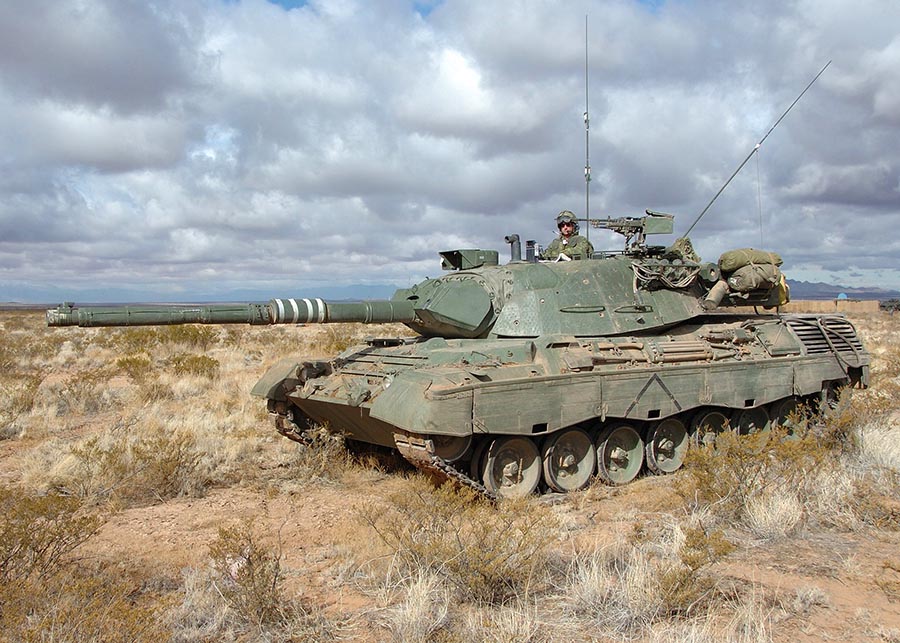By Captain Scott Franklin, office of the Director Land Requirements
Gatineau, Quebec — Royal Canadian Armour Corps (RCAC) members who had the privilege of working with Leopard 1 Main Battle Tanks (MBTs) are saying farewell to the venerable workhorses, whose service to the Canadian Armed Forces (CAF) is coming to an end.
It is a bittersweet time for armour officers and soldiers, given that only last year, they were marking the 40th anniversary of the introduction of the first Leopard 1s to the CAF. The red ruby is the traditional 40th anniversary stone and they would undoubtedly see the Leopard 1 family as a precious stone in the CAF crown.
“These were by far the best vehicles I had the opportunity to work with in my 38 years of service,” said Major Robert Bouchard. “I went through my Armour Officer training when the Leopard 1 fleet was still new. All the young RCAC officers were hoping to serve in Germany or Gagetown on the Leopard 1 tank.”
The first Leopard 1 MBTs were loaned to the CAF by West Germany in 1977. Their superior accuracy, ease of use and reliability bore fruit early when the Royal Canadian Dragoons’ (RCD’s) B Squadron won the NATO tank gunnery competition that year against major Allied nations.
Canada began to receive its full order of 114 Leopard 1 C1 MBTs in 1978.
Most of the new Leopard 1s were originally stationed with 4th Canadian Mechanized Brigade Group at Canadian Forces Base Lahr in West Germany and operated by the RCD. The remainder were distributed between Canadian Forces Base Gagetown (now 5th Canadian Division Support Base Gagetown) with C Squadron RCD, known as the “flyover squadron,” and the armour school.
In the early 1990s, eight Leopard 1 Armoured Engineer Vehicles (AEVs), also known as Badgers, were acquired. These vehicles, based on the Leopard 1 Armoured Recovery Vehicle (ARV) chassis, were used by an engineer squadron in Germany and the engineer school at CFB Gagetown.
With the closing of CFB Lahr in 1993, the Leopard 1s were repatriated to Canada and redistributed to armour regiments and engineer squadrons stationed at Brigade Groups in Valcartier, Petawawa and Edmonton, as well as the Combat Training Centre at CFB Gagetown.
In 1995, the Leopard 1 C1s were upgraded with add-on armour to provide more protection. Two Leopard 1C1s of this configuration were deployed to Bosnia for use in engineering tasks using mine rollers and mine ploughs.
In 1999, further upgrades to the Leopard 1 MBT included replacing the welded turrets with cast turrets, a new gun sight, an improved hydraulic turret drive, and new turret armour. This upgrade was referred to as the Leopard 1 C2. An acceptance ceremony for the Leopard 1 C2 was held at the Cartier Square Drill hall in Ottawa in September 2001.
In 2006, a 15-tank squadron with five operational spares, four ARVs and four AEVs were deployed to Afghanistan to support operations in the Kandahar area and remained there until the repatriation of the Canadian contingent in 2011.
During this deployment, the Leopard 1 family was further upgraded with mine belly-plates for additional protection from improvised explosive devices (IEDs) and mines, a crew chiller system and thermal covers to protect the crew from the excessive heat of the south Asian desert. Also during the Afghanistan deployment, the Leopard 1 MBTs were augmented by the Leopard 2 A6M and Leopard 2 A4M.
With the delivery of the new Leopard 2 Tank Mobility Implements in the fall of 2017, the last Leopard 1 tanks have been parked for good.
For 40 years, Canadian soldiers relied on the Leopard 1 to provide direct fire support to manoeuvring forces. They will continue their over-watch duties in front of many Canadian Army buildings and bases.


(Français) Je signale un lapsus dans la phrase suivante :
In the early “1990s”, eight Leopard 1 Armoured Engineer Vehicles (AEVs), also known as Badgers, were acquired.
Achat dans les années 1980 puisqu’en employé par le “4 Combat Engineer Regiment” en 1989. Mais un organigramme indique 9 Badgers, pas 8. Vous confirmé votre chiffre ?
Cordialement.
I was lucky enough to be one of the first troop leaders as an 8CH flyover officer with the RCD in Lahr in 1977. At one point my troop, 3 Troop , B Sqn, had 4 Centurions and 4 Leopards. Interesting times. I also had the privilege to crew command one of the first C1s at a mobility demonstration for the public in Petawawa late in 1977. Got quoted in the local paper! Good times.
John Gredley 8 CH